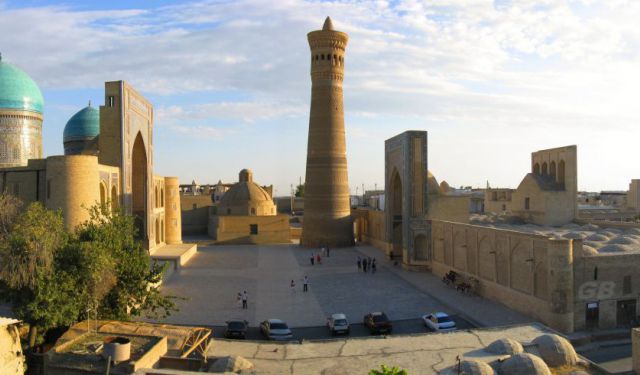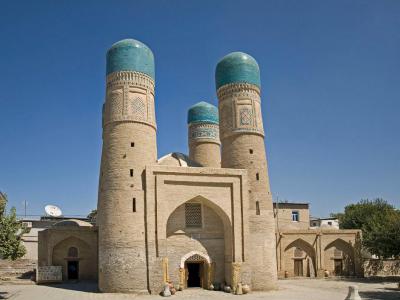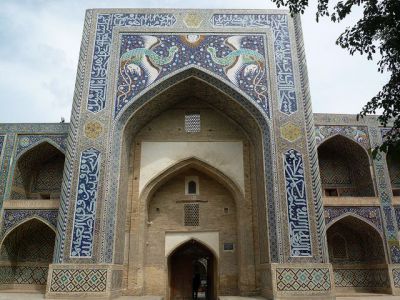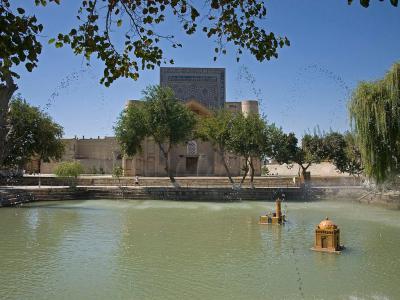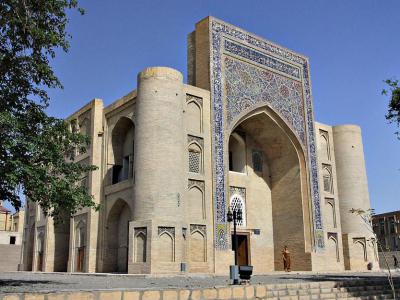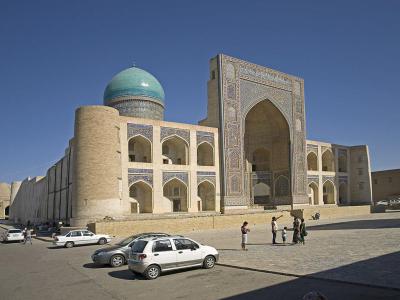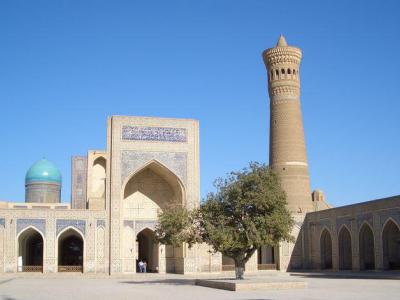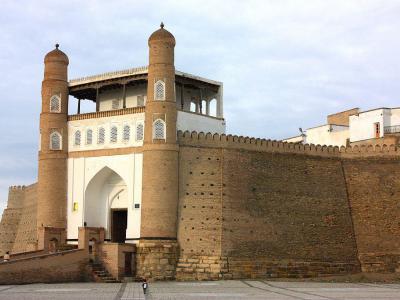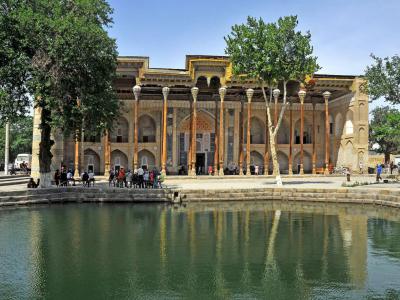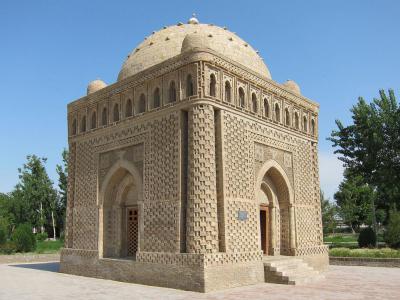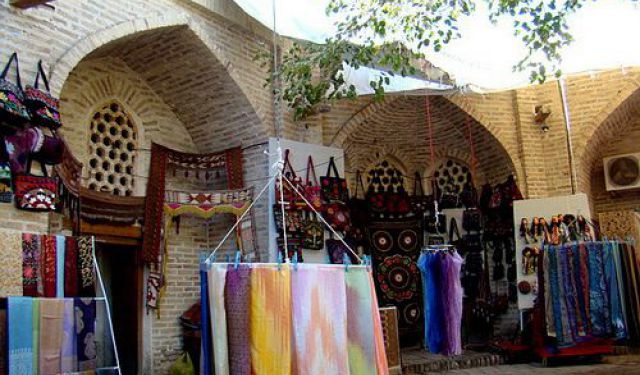Bukhara Introduction Walking Tour (Self Guided), Bukhara
Alexander the Great reportedly stated that "a carpet from Bukhara is worth a kingdom!" One and a half millennia after him, Ibn Battuta, a 14th-century Moroccan traveler, described this splendid city as "a meeting place of the nations and a market of the world."
Centuries on, the pearl of modern-day Uzbekistan, Bukhara, is still very much the place capable of leaving a lasting impression on those who venture within its embrace.
The city's illustrious history dates back over two thousand years. Once an important center of trade along the ancient Silk Road that linked Europe and Asia, Bukhara flourished as a major intellectual and economic hub of the Islamic world during the Samanid dynasty (9th-10th centuries). Later, Bukhara became a part of various empires, including the Mongols, Timurids, and the Uzbek Shaybanid and Manghit dynasties.
It remained an influential city until the Russian Empire's conquest in the late 19th century. As a part of Uzbekistan, Bukhara was eventually incorporated into the Soviet Union and remained there until the dissolution of the USSR in 1991.
The origin of the name "Bukhara" is not entirely clear. Some theories suggest that it may have come from the Sanskrit word "Vihara," meaning "monastery" or "temple." This theory suggests that the name evolved from the presence of Buddhist monasteries in the region before the advent of Islam. Another possible origin is the Persian word "Bukhar," which translates to "lucky" or "fortunate."
Indeed, Bukhara may consider itself fortunate to be blessed with architectural splendor and cultural treasures that are fit to showcase "the entire beauty of the East".
For centuries, the ancient Ark Citadel served as a residence for Bukhara's rulers. The architectural ensemble centered around the Kalyan Minaret, a towering 12th-century structure, also includes the Kalyan Mosque and the Mir-i-Arab Madrasa. Another architectural marvel, one of the oldest surviving buildings in Central Asia, is the 9th-century Samanid Mausoleum.
The historic Lab-i Hauz area, whose name translates from Persian as “by the pond,” features a large pond surrounded by traditional tea houses and restaurants. Today, it serves as a popular gathering spot with a charming atmosphere.
Rightfully named a city museum, boasting nearly 140 architectural monuments (!!!), Bukhara is a captivating destination for history and culture enthusiasts. To find your way around this open-air sanctuary of Islamic art, "where the grandeur of the past stands tall amidst the changing tides of time," take our self-guided walking tour.
Centuries on, the pearl of modern-day Uzbekistan, Bukhara, is still very much the place capable of leaving a lasting impression on those who venture within its embrace.
The city's illustrious history dates back over two thousand years. Once an important center of trade along the ancient Silk Road that linked Europe and Asia, Bukhara flourished as a major intellectual and economic hub of the Islamic world during the Samanid dynasty (9th-10th centuries). Later, Bukhara became a part of various empires, including the Mongols, Timurids, and the Uzbek Shaybanid and Manghit dynasties.
It remained an influential city until the Russian Empire's conquest in the late 19th century. As a part of Uzbekistan, Bukhara was eventually incorporated into the Soviet Union and remained there until the dissolution of the USSR in 1991.
The origin of the name "Bukhara" is not entirely clear. Some theories suggest that it may have come from the Sanskrit word "Vihara," meaning "monastery" or "temple." This theory suggests that the name evolved from the presence of Buddhist monasteries in the region before the advent of Islam. Another possible origin is the Persian word "Bukhar," which translates to "lucky" or "fortunate."
Indeed, Bukhara may consider itself fortunate to be blessed with architectural splendor and cultural treasures that are fit to showcase "the entire beauty of the East".
For centuries, the ancient Ark Citadel served as a residence for Bukhara's rulers. The architectural ensemble centered around the Kalyan Minaret, a towering 12th-century structure, also includes the Kalyan Mosque and the Mir-i-Arab Madrasa. Another architectural marvel, one of the oldest surviving buildings in Central Asia, is the 9th-century Samanid Mausoleum.
The historic Lab-i Hauz area, whose name translates from Persian as “by the pond,” features a large pond surrounded by traditional tea houses and restaurants. Today, it serves as a popular gathering spot with a charming atmosphere.
Rightfully named a city museum, boasting nearly 140 architectural monuments (!!!), Bukhara is a captivating destination for history and culture enthusiasts. To find your way around this open-air sanctuary of Islamic art, "where the grandeur of the past stands tall amidst the changing tides of time," take our self-guided walking tour.
How it works: Download the app "GPSmyCity: Walks in 1K+ Cities" from Apple App Store or Google Play Store to your mobile phone or tablet. The app turns your mobile device into a personal tour guide and its built-in GPS navigation functions guide you from one tour stop to next. The app works offline, so no data plan is needed when traveling abroad.
Bukhara Introduction Walking Tour Map
Guide Name: Bukhara Introduction Walking Tour
Guide Location: Uzbekistan » Bukhara (See other walking tours in Bukhara)
Guide Type: Self-guided Walking Tour (Sightseeing)
# of Attractions: 9
Tour Duration: 2 Hour(s)
Travel Distance: 3.4 Km or 2.1 Miles
Author: DanaOffice
Sight(s) Featured in This Guide:
Guide Location: Uzbekistan » Bukhara (See other walking tours in Bukhara)
Guide Type: Self-guided Walking Tour (Sightseeing)
# of Attractions: 9
Tour Duration: 2 Hour(s)
Travel Distance: 3.4 Km or 2.1 Miles
Author: DanaOffice
Sight(s) Featured in This Guide:
- Chor-Minor Madrasa
- Nadir Divan-Beghi Madrasah
- Lab-i Hauz
- Nadir Divan-Begi Khanaka
- Mir-i Arab Madrasa
- Kalyan Minaret and Mosque
- The Ark Citadel
- Bolo-Khaouz Mosque
- Samanid Mausoleum
1) Chor-Minor Madrasa (must see)
Chor-Minor, also known as the Madrasa of Khalif Niyaz-kul, is a captivating architectural gem. This historic gatehouse, once part of a madrasa that no longer exists, holds great cultural and historical significance. It is nestled in a charming lane northeast of the Lyab-i Hauz complex and is recognized as a cultural heritage monument, forming part of the prestigious World Heritage Site, the Historic Centre of Bukhara.
The name Chor-Minor translates to "four minarets" in Persian, aptly describing the building's unique features. Constructed in 1807 during the rule of the Manghit dynasty, this remarkable structure was the brainchild of Khalif Niyaz-kul, a prosperous Bukharan of Turkmen origin. The focal point of the edifice is the mosque, showcasing a typical Central Asian interior. The cupola of the mosque not only enhances the architectural beauty but also provides excellent acoustics, making it a designated space for Sufi 'dhikr-hana' ceremonies. These spiritual rituals often involve recitation, singing, and instrumental music.
The central edifice of Chor-Minor is flanked by dwelling rooms, some of which have unfortunately collapsed over time, leaving behind only their foundations as a testament to their existence. Adjacent to the Char-Minar, visitors will find a tranquil pool, likely dating back to the same period as the rest of the building complex. Today, Chor-Minor finds itself surrounded by small houses and shops, creating a unique blend of architectural heritage and bustling everyday life.
The towers of Chor-Minor, despite their name, were not originally intended as minarets. Instead, three of them were utilized for storage purposes, while the fourth tower features a staircase leading to the top floor. Each tower boasts distinct decorative motifs, which reflect a fascinating fusion of cultural influences. Observers can identify elements reminiscent of a cross, a Christian fish motif, a Buddhist praying-wheel, alongside Zoroastrian and Islamic motifs. The domes crowning the towers are adorned with exquisite blue ceramic tiles, adding an enchanting touch to the overall aesthetic.
The name Chor-Minor translates to "four minarets" in Persian, aptly describing the building's unique features. Constructed in 1807 during the rule of the Manghit dynasty, this remarkable structure was the brainchild of Khalif Niyaz-kul, a prosperous Bukharan of Turkmen origin. The focal point of the edifice is the mosque, showcasing a typical Central Asian interior. The cupola of the mosque not only enhances the architectural beauty but also provides excellent acoustics, making it a designated space for Sufi 'dhikr-hana' ceremonies. These spiritual rituals often involve recitation, singing, and instrumental music.
The central edifice of Chor-Minor is flanked by dwelling rooms, some of which have unfortunately collapsed over time, leaving behind only their foundations as a testament to their existence. Adjacent to the Char-Minar, visitors will find a tranquil pool, likely dating back to the same period as the rest of the building complex. Today, Chor-Minor finds itself surrounded by small houses and shops, creating a unique blend of architectural heritage and bustling everyday life.
The towers of Chor-Minor, despite their name, were not originally intended as minarets. Instead, three of them were utilized for storage purposes, while the fourth tower features a staircase leading to the top floor. Each tower boasts distinct decorative motifs, which reflect a fascinating fusion of cultural influences. Observers can identify elements reminiscent of a cross, a Christian fish motif, a Buddhist praying-wheel, alongside Zoroastrian and Islamic motifs. The domes crowning the towers are adorned with exquisite blue ceramic tiles, adding an enchanting touch to the overall aesthetic.
2) Nadir Divan-Beghi Madrasah
Nadir Divan-begi Madrasah is an integral part of the architectural complex surrounding the renowned Lyabi-Hauz in Bukhara. This exquisite madrasah and the adjacent khanaka were named after the vizier Nadir, who commissioned their construction. Vizier Nadir served at the court of Imamkuli-khan, one of the powerful representatives of the Ashtarkhanid dynasty, who ruled over Bukhara from 1611 to 1642.
Initially, Nadir Divan-begi intended to build a khanaka, a place for Sufis to reflect and rest. Later, a caravanserai was added to the complex. However, during the grand opening, Imamkuli-khan declared that the caravanserai was built in the glory of Allah, prompting the vizier to transform it into a madrasah.
The architectural style of Nadir Divan-begi Madrasah follows the typical Muslim monuments of Central Asia. However, it also incorporates unusual elements such as depictions of birds, animals, and the sun, which are atypical for Islamic architecture. The design of the madrasah was modeled after the Sherdor in Samarkand, but the renowned lions at the portal were replaced with mythical birds symbolizing happiness.
During the transformation from caravanserai to madrasah, the vizier ordered the addition of a loggia, a portal, and angular towers to the main facade. The khanaka, on the other hand, took the form of a multi-chambered building with a central dome hall. The hudjrs in the khanaka were located on the first floor, embedded in the lateral walls and corners of the structure.
The main entrance of Nadir Divan-begi Madrasah is elongated, deviating from the typical Central Asian architectural style. In addition to the architectural features, the vizier also commissioned the construction of a pool near the khanaka and madrasah. Stone steps leading to the pool were added, and this artificial reservoir eventually became known as Lyabi Hauz, now one of the most iconic landmarks in Bukhara.
Initially, Nadir Divan-begi intended to build a khanaka, a place for Sufis to reflect and rest. Later, a caravanserai was added to the complex. However, during the grand opening, Imamkuli-khan declared that the caravanserai was built in the glory of Allah, prompting the vizier to transform it into a madrasah.
The architectural style of Nadir Divan-begi Madrasah follows the typical Muslim monuments of Central Asia. However, it also incorporates unusual elements such as depictions of birds, animals, and the sun, which are atypical for Islamic architecture. The design of the madrasah was modeled after the Sherdor in Samarkand, but the renowned lions at the portal were replaced with mythical birds symbolizing happiness.
During the transformation from caravanserai to madrasah, the vizier ordered the addition of a loggia, a portal, and angular towers to the main facade. The khanaka, on the other hand, took the form of a multi-chambered building with a central dome hall. The hudjrs in the khanaka were located on the first floor, embedded in the lateral walls and corners of the structure.
The main entrance of Nadir Divan-begi Madrasah is elongated, deviating from the typical Central Asian architectural style. In addition to the architectural features, the vizier also commissioned the construction of a pool near the khanaka and madrasah. Stone steps leading to the pool were added, and this artificial reservoir eventually became known as Lyabi Hauz, now one of the most iconic landmarks in Bukhara.
3) Lab-i Hauz (must see)
Lyab-i Hauz, also known as Lab-i Hauz or Lyab-i Khauz, is an area surrounding one of the few remaining hauz pools that have survived. The name "Lyab-i Hauz" translates to "by the pool" in Persian, accurately describing the location. In the past, these hauz pools served as the primary water source for the city until the 1920s and 1930s when most of them were filled in due to disease concerns.
The Lab-i Hauz pool itself has managed to survive over the years and remains the centerpiece of a magnificent architectural ensemble. This ensemble, constructed during the 16th and 17th centuries, has undergone little change since its creation. Three sides of the pool are surrounded by notable structures. To the north stands the Kukeldash Madrasah, the largest madrasah in Bukhara. Adjacent to the pool on the west and east sides are two religious buildings commissioned by Nadir Divan-Beghi: a khanqah (lodging house for itinerant Sufis) and a madrasah, respectively. Additionally, the small Qāzī-e Kalān Nasreddīn madrasa, now demolished, was once located beside the Kukeldash madrasah.
Today, the Lab-i Hauz presents a rectangular-shaped pool measuring 46 by 36 meters. It stretches from the east to the west and is adorned with lush greenery provided by century-old trees. The pool's edges are designed as a descending staircase made of large blocks of yellowish limestone, adding to its visual appeal.
The Lab-i Hauz pool itself has managed to survive over the years and remains the centerpiece of a magnificent architectural ensemble. This ensemble, constructed during the 16th and 17th centuries, has undergone little change since its creation. Three sides of the pool are surrounded by notable structures. To the north stands the Kukeldash Madrasah, the largest madrasah in Bukhara. Adjacent to the pool on the west and east sides are two religious buildings commissioned by Nadir Divan-Beghi: a khanqah (lodging house for itinerant Sufis) and a madrasah, respectively. Additionally, the small Qāzī-e Kalān Nasreddīn madrasa, now demolished, was once located beside the Kukeldash madrasah.
Today, the Lab-i Hauz presents a rectangular-shaped pool measuring 46 by 36 meters. It stretches from the east to the west and is adorned with lush greenery provided by century-old trees. The pool's edges are designed as a descending staircase made of large blocks of yellowish limestone, adding to its visual appeal.
4) Nadir Divan-Begi Khanaka
Nadir Divan-Begi Khanaka, situated at the western end of the Lyab-i Hauz ensemble in central Bukhara, is a sufi lodge or retreat that dates back to the 1620s. It was established by vizier Nadir Divan-begi, who was the maternal uncle of Imam Quli Khan, the ruler of Bukhara from 1611 to 1641.
The khanaka is part of a trio of buildings surrounding a pond, known as Lyab-i Hauz, which gives the ensemble its name. The pond was fed by the Shah Rud canal to the south. Following the urban planning principle of kosh, the vizier arranged for two public monuments to face each other across the pond: the khanaka and a madrasa, both bearing his name. The third monument, located to the north, was the older Kukeldash Madrasa, built in 1568-69.
The khanaka served as a gathering place for Sufis to conduct their daily prayers, known as salat, as well as specific ceremonies associated with different Sufi orders. The central hall, called the zikr-khana, functioned as a mosque and featured a large mihrab (niche) on the qibla wall, facing Mecca to guide worshippers in the correct direction. The mihrab is considered the most beautiful element of the design, adorned with intricately decorated muqarnas (stalactite vaults) painted in various colors.
During the 17th century in Bukhara, the zikr-khana also served as a meeting place for the city's elite and the resident Sufi masters of the khanaka. Here, notable individuals would participate in Sufi rituals and listen to teachings on Sufi doctrines. In front of the mihrab, a niche contains two nondescript doors on either side, leading to hujras (cells) located in the corners of the building. These cells served as dormitories and private retreat spaces.
Apart from the ornate mihrab, the rest of the domed hall is whitewashed, although it is believed that additional decorations may have been present originally. Today, the hall houses a museum of ceramics.
The exterior of Nadir Divan-Begi Khanaka features modest ornamentation, except for the monumental pishtaq on the east facade. The pishtaq is covered in mosaic faience tiles arranged in geometric and floral patterns. Tile bands with calligraphic inscriptions frame the edges of the portal on three sides. While much of the tile work has been restored, it is worth noting that early 20th-century photographs show significant wear over the centuries.
The khanaka is part of a trio of buildings surrounding a pond, known as Lyab-i Hauz, which gives the ensemble its name. The pond was fed by the Shah Rud canal to the south. Following the urban planning principle of kosh, the vizier arranged for two public monuments to face each other across the pond: the khanaka and a madrasa, both bearing his name. The third monument, located to the north, was the older Kukeldash Madrasa, built in 1568-69.
The khanaka served as a gathering place for Sufis to conduct their daily prayers, known as salat, as well as specific ceremonies associated with different Sufi orders. The central hall, called the zikr-khana, functioned as a mosque and featured a large mihrab (niche) on the qibla wall, facing Mecca to guide worshippers in the correct direction. The mihrab is considered the most beautiful element of the design, adorned with intricately decorated muqarnas (stalactite vaults) painted in various colors.
During the 17th century in Bukhara, the zikr-khana also served as a meeting place for the city's elite and the resident Sufi masters of the khanaka. Here, notable individuals would participate in Sufi rituals and listen to teachings on Sufi doctrines. In front of the mihrab, a niche contains two nondescript doors on either side, leading to hujras (cells) located in the corners of the building. These cells served as dormitories and private retreat spaces.
Apart from the ornate mihrab, the rest of the domed hall is whitewashed, although it is believed that additional decorations may have been present originally. Today, the hall houses a museum of ceramics.
The exterior of Nadir Divan-Begi Khanaka features modest ornamentation, except for the monumental pishtaq on the east facade. The pishtaq is covered in mosaic faience tiles arranged in geometric and floral patterns. Tile bands with calligraphic inscriptions frame the edges of the portal on three sides. While much of the tile work has been restored, it is worth noting that early 20th-century photographs show significant wear over the centuries.
5) Mir-i Arab Madrasa (must see)
The Mir-i Arab Madrasa is an integral part of the Po-i-Kalyan ensemble located in the heart of Bukhara. This ensemble includes three significant structures: the 12th-century Kalyan Minaret, the 16th-century Kalyan Mosque, and the Mir-i Arab Madrasa.
The name "Mir-i Arab" translates to "Prince of the Arabs" and pays tribute to Sheikh Abdullah Yamani of Yemen. Sheikh Yamani gained prominence as the spiritual leader of Bukhara's Muslim community. He served as a pir (spiritual adviser) to several Khans and was ultimately laid to rest within the madrasa, which now bears his name.
The architects of the Mir-i Arab Madrasa would have been familiar with numerous contemporary examples in Central Asia, such as the Ulugh Beg Madrasa in Samarkand. The Mir-i Arab Madrasa adheres to similar design principles. Its two-story facade is adorned with glazed mosaic faience tiles, a decorative treatment popularized during the Timurid era. However, unlike the Ulugh Beg Madrasa, the Mir-i Arab Madrasa features squat and heavy corners, giving it a fortress-like appearance.
The interior of the madrasa consists of numerous small cells called hujras, which serve as student dormitories. Lecture halls and a large domed room in the northwest corner house the cenotaph of Sheikh Yamani and the graves of devotees and family members. A domed mosque occupies the same position on the south side. Both domes are raised on high drums and decorated with turquoise tiles and muqarnas-style vaulting, creating a captivating visual display.
The name "Mir-i Arab" translates to "Prince of the Arabs" and pays tribute to Sheikh Abdullah Yamani of Yemen. Sheikh Yamani gained prominence as the spiritual leader of Bukhara's Muslim community. He served as a pir (spiritual adviser) to several Khans and was ultimately laid to rest within the madrasa, which now bears his name.
The architects of the Mir-i Arab Madrasa would have been familiar with numerous contemporary examples in Central Asia, such as the Ulugh Beg Madrasa in Samarkand. The Mir-i Arab Madrasa adheres to similar design principles. Its two-story facade is adorned with glazed mosaic faience tiles, a decorative treatment popularized during the Timurid era. However, unlike the Ulugh Beg Madrasa, the Mir-i Arab Madrasa features squat and heavy corners, giving it a fortress-like appearance.
The interior of the madrasa consists of numerous small cells called hujras, which serve as student dormitories. Lecture halls and a large domed room in the northwest corner house the cenotaph of Sheikh Yamani and the graves of devotees and family members. A domed mosque occupies the same position on the south side. Both domes are raised on high drums and decorated with turquoise tiles and muqarnas-style vaulting, creating a captivating visual display.
6) Kalyan Minaret and Mosque (must see)
The Kalyan Minaret and Mosque is a remarkable testament to the architectural prowess of the Islamic world in the 12th century. It is also known as the Tower of Death because until as recently as the early twentieth century, criminals were executed by being thrown from the top.
The Kalyan Minaret, built in 1127, is an example of both civil engineering and artistic creativity. Towering at approximately 47 meters (154 feet) high, it is a notable landmark of Bukhara and can be seen from virtually any point in the city. The structure is adorned with intricate brickwork and blue tiles, featuring various geometric and floral patterns – a testament to the region's artistic style.
Adjacent to the minaret is the grand Kalyan Mosque, completed in 1514, which replaces an older mosque destroyed by Genghis Khan. The mosque can accommodate up to twelve thousand worshippers and is surrounded by a spacious courtyard. Its majestic facade, ornate arches, and multi-domed design, together with the minaret, create an awe-inspiring complex, reflecting the Islamic architectural tradition of the time.
These monumental structures are not only important religious centers but also significant cultural and historical landmarks. They have stood witness to centuries of history and remain emblematic of Bukhara's Islamic architectural heritage. The Kalyan Minaret and Mosque complex attracts scholars, tourists, and pilgrims from around the globe, making it one of the most visited sites in Uzbekistan.
The Kalyan Minaret, built in 1127, is an example of both civil engineering and artistic creativity. Towering at approximately 47 meters (154 feet) high, it is a notable landmark of Bukhara and can be seen from virtually any point in the city. The structure is adorned with intricate brickwork and blue tiles, featuring various geometric and floral patterns – a testament to the region's artistic style.
Adjacent to the minaret is the grand Kalyan Mosque, completed in 1514, which replaces an older mosque destroyed by Genghis Khan. The mosque can accommodate up to twelve thousand worshippers and is surrounded by a spacious courtyard. Its majestic facade, ornate arches, and multi-domed design, together with the minaret, create an awe-inspiring complex, reflecting the Islamic architectural tradition of the time.
These monumental structures are not only important religious centers but also significant cultural and historical landmarks. They have stood witness to centuries of history and remain emblematic of Bukhara's Islamic architectural heritage. The Kalyan Minaret and Mosque complex attracts scholars, tourists, and pilgrims from around the globe, making it one of the most visited sites in Uzbekistan.
7) The Ark Citadel (must see)
The Ark Citadel is a magnificent fortress with a history dating back to the 5th century AD. It served as both a military stronghold and a town, housing the royal courts that ruled over the surrounding region. While the Ark was a formidable fortress, it eventually succumbed to Russian forces in 1920 and is now a popular tourist destination, featuring museums that showcase its rich history.
The Ark houses various museums and restored areas that offer insights into its past. The archaeological museum presents artifacts and discoveries from the site, allowing visitors to delve into the ancient history of Bukhara. The throne room provides a glimpse into the opulent lifestyle of the ruling elites, while the reception and coronation court reflect the grandeur of ceremonial events that took place within the fortress. The local history museum sheds light on the cultural heritage of Bukhara and its significance in the region. Additionally, the court mosque stands as a testament to the religious practices that were central to the daily lives of the fortress inhabitants.
Built upon earlier structures, the Ark Citadel has layers of history buried deep beneath its foundations, indicating the presence of previous fortresses that were constructed and destroyed on the same site. The earliest reference to the Ark can be found in Narshakhi's "History of Bukhara," written between the 9th and 10th centuries. Legend attributes the creation of the Ark to the heroic figure Siyavusha, who built a palace within the boundaries of a bull's skin-an impossible task according to the ruler of Afrosiaba. However, Siyavusha ingeniously connected the ends of the bull's skin, allowing him to fulfill the condition and marry the ruler's daughter.
The Ark Citadel faced significant damage during the Russian Civil War, particularly during the Battle of Bukhara in 1920. Red Army troops, commanded by Mikhail Frunze, heavily bombarded the Ark, leaving a substantial portion of the fortress in ruins. Additionally, there is speculation that the last Emir, Mohammed Alim Khan, ordered the destruction of the Ark to prevent its sacred places, particularly the harem, from being desecrated by the Bolsheviks. These events have left their mark on the structure, but its historical and architectural significance remains intact.
Today, visitors can explore the Ark Citadel and immerse themselves in the storied past of Bukhara. The fortress stands as a symbol of the region's rich history and offers a glimpse into the lives of those who once resided within its walls.
The Ark houses various museums and restored areas that offer insights into its past. The archaeological museum presents artifacts and discoveries from the site, allowing visitors to delve into the ancient history of Bukhara. The throne room provides a glimpse into the opulent lifestyle of the ruling elites, while the reception and coronation court reflect the grandeur of ceremonial events that took place within the fortress. The local history museum sheds light on the cultural heritage of Bukhara and its significance in the region. Additionally, the court mosque stands as a testament to the religious practices that were central to the daily lives of the fortress inhabitants.
Built upon earlier structures, the Ark Citadel has layers of history buried deep beneath its foundations, indicating the presence of previous fortresses that were constructed and destroyed on the same site. The earliest reference to the Ark can be found in Narshakhi's "History of Bukhara," written between the 9th and 10th centuries. Legend attributes the creation of the Ark to the heroic figure Siyavusha, who built a palace within the boundaries of a bull's skin-an impossible task according to the ruler of Afrosiaba. However, Siyavusha ingeniously connected the ends of the bull's skin, allowing him to fulfill the condition and marry the ruler's daughter.
The Ark Citadel faced significant damage during the Russian Civil War, particularly during the Battle of Bukhara in 1920. Red Army troops, commanded by Mikhail Frunze, heavily bombarded the Ark, leaving a substantial portion of the fortress in ruins. Additionally, there is speculation that the last Emir, Mohammed Alim Khan, ordered the destruction of the Ark to prevent its sacred places, particularly the harem, from being desecrated by the Bolsheviks. These events have left their mark on the structure, but its historical and architectural significance remains intact.
Today, visitors can explore the Ark Citadel and immerse themselves in the storied past of Bukhara. The fortress stands as a symbol of the region's rich history and offers a glimpse into the lives of those who once resided within its walls.
8) Bolo-Khaouz Mosque
The Bolo-Khaouz Mosque is a significant historical mosque located in Bukhara. Constructed in 1712, it holds great cultural and architectural value and is recognized as a UNESCO World Heritage Site, along with other parts of the historic city of Bukhara. The mosque played a crucial role as a Friday mosque during the period when the emir of Bukhara was under the control of Bolshevik Russia in the 1920s.
The mosque features a rectangular shape and is characterized by its distinctive elements. In 1917, thin columns made of painted wood were added to the front part of the iwan (entrance) to provide additional support to the bulged roof of the summer prayer room. These columns are adorned with colored muqarnas, showcasing intricate geometric designs. The interior of the mosque follows the typical 18th-century Central Asian style, reflecting the artistic and architectural influences of the region.
The Bolo-Khaouz Mosque comprises two main prayer areas. During the winter season, worshippers gather in a room with four columns and several entrances. The summer prayer room, known as the iwan, stands 12 meters high and features a 20-pillared hall measuring 42 x 10 meters. This impressive space is bordered by bulged roofs sustained with twenty wooden columns, which rest on a concrete foundation. The iwan serves as a place of prayer during the summer months and is attached to three sides of the winter hall.
In front of the mosque, there is a howz, a traditional rectangular pool used for ritual ablutions before prayer. This howz enhances the spiritual ambiance of the mosque and adds to its overall architectural charm. Additionally, a small minaret, built in 1917, stands to the side of the mosque, further contributing to the visual appeal of the complex.
The mosque features a rectangular shape and is characterized by its distinctive elements. In 1917, thin columns made of painted wood were added to the front part of the iwan (entrance) to provide additional support to the bulged roof of the summer prayer room. These columns are adorned with colored muqarnas, showcasing intricate geometric designs. The interior of the mosque follows the typical 18th-century Central Asian style, reflecting the artistic and architectural influences of the region.
The Bolo-Khaouz Mosque comprises two main prayer areas. During the winter season, worshippers gather in a room with four columns and several entrances. The summer prayer room, known as the iwan, stands 12 meters high and features a 20-pillared hall measuring 42 x 10 meters. This impressive space is bordered by bulged roofs sustained with twenty wooden columns, which rest on a concrete foundation. The iwan serves as a place of prayer during the summer months and is attached to three sides of the winter hall.
In front of the mosque, there is a howz, a traditional rectangular pool used for ritual ablutions before prayer. This howz enhances the spiritual ambiance of the mosque and adds to its overall architectural charm. Additionally, a small minaret, built in 1917, stands to the side of the mosque, further contributing to the visual appeal of the complex.
9) Samanid Mausoleum (must see)
The Samanid Mausoleum is a revered architectural gem located in the historic core of Bukhara. Situated within a park that was once an ancient cemetery, this mausoleum stands as one of the most esteemed examples of Central Asian architecture. It was built in the 9th or 10th century, between 892 and 943, as the final resting place of Ismail Samani, a prominent and influential amir of the Samanid dynasty.
During the 9th and 10th centuries, the Samanids ruled over Bukhara and the surrounding regions as part of the Persian dynasty. While initially serving as governors under the Abbasid Caliphate, the Samanids gradually gained virtual independence from Baghdad. The Samanid Mausoleum stands as a testament to their power and influence during this period.
For many years, the lower part of the mausoleum remained buried beneath two meters of sediment. However, extensive restoration efforts have cleared the foundation of these obstacles, allowing the mausoleum to be observed from all sides, as originally intended by its builders. This restoration work has brought the monument back to its former glory, offering visitors an opportunity to appreciate its architectural splendor.
The construction of the Samanid Mausoleum marked a significant era in the evolution of Central Asian architecture. It signaled a revival of the region's architectural traditions after the Arab conquests. The mausoleum's architects followed the ancient tradition of baked brick construction, but executed it to an exceptionally high standard. The craftsmanship and artistic details of the brickwork are truly remarkable, showcasing traditional features that date back to pre-Islamic times.
The Samanid Mausoleum's influence extends beyond Bukhara. It has served as a source of inspiration for other architectural masterpieces, including the mausoleum of Muhammad Ali Jinnah, the founding father of Pakistan, known as Mazar-e-Quaid. The design of Mazar-e-Quaid draws inspiration from the Samanid Mausoleum, highlighting its enduring legacy and architectural significance.
During the 9th and 10th centuries, the Samanids ruled over Bukhara and the surrounding regions as part of the Persian dynasty. While initially serving as governors under the Abbasid Caliphate, the Samanids gradually gained virtual independence from Baghdad. The Samanid Mausoleum stands as a testament to their power and influence during this period.
For many years, the lower part of the mausoleum remained buried beneath two meters of sediment. However, extensive restoration efforts have cleared the foundation of these obstacles, allowing the mausoleum to be observed from all sides, as originally intended by its builders. This restoration work has brought the monument back to its former glory, offering visitors an opportunity to appreciate its architectural splendor.
The construction of the Samanid Mausoleum marked a significant era in the evolution of Central Asian architecture. It signaled a revival of the region's architectural traditions after the Arab conquests. The mausoleum's architects followed the ancient tradition of baked brick construction, but executed it to an exceptionally high standard. The craftsmanship and artistic details of the brickwork are truly remarkable, showcasing traditional features that date back to pre-Islamic times.
The Samanid Mausoleum's influence extends beyond Bukhara. It has served as a source of inspiration for other architectural masterpieces, including the mausoleum of Muhammad Ali Jinnah, the founding father of Pakistan, known as Mazar-e-Quaid. The design of Mazar-e-Quaid draws inspiration from the Samanid Mausoleum, highlighting its enduring legacy and architectural significance.
Walking Tours in Bukhara, Uzbekistan
Create Your Own Walk in Bukhara
Creating your own self-guided walk in Bukhara is easy and fun. Choose the city attractions that you want to see and a walk route map will be created just for you. You can even set your hotel as the start point of the walk.
Bukhara Shopping Tour
Bukhara, “a jewel of the Silk Road”, has been a commercial city since ancient times. Shopping here can still be a memorable experience for those keen to immerse themselves in the vibrant atmosphere of Central Asian trade.
Bazaars are the heartbeats of Bukhara. Historically, these domed venues were located at crossroads, to facilitate passing commerce, and dealt in a variety of goods. There,... view more
Tour Duration: 1 Hour(s)
Travel Distance: 0.6 Km or 0.4 Miles
Bazaars are the heartbeats of Bukhara. Historically, these domed venues were located at crossroads, to facilitate passing commerce, and dealt in a variety of goods. There,... view more
Tour Duration: 1 Hour(s)
Travel Distance: 0.6 Km or 0.4 Miles
The Most Popular Cities
/ view all
